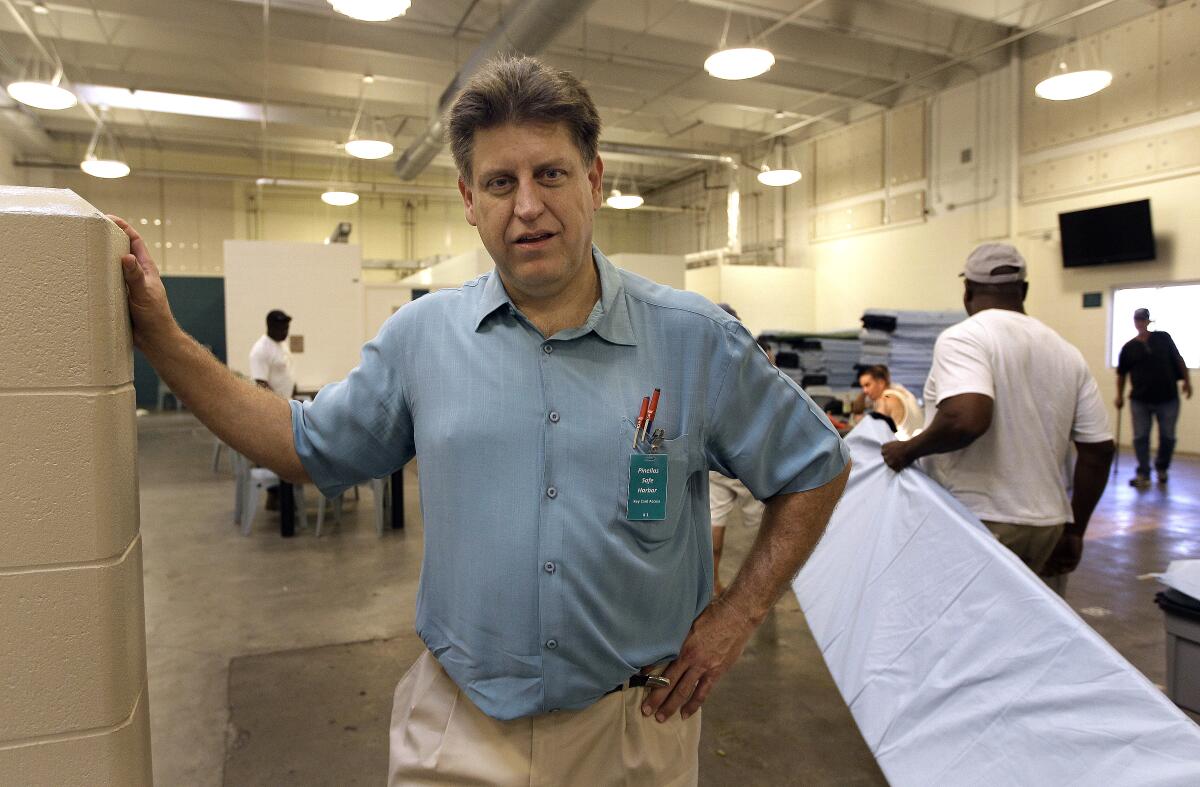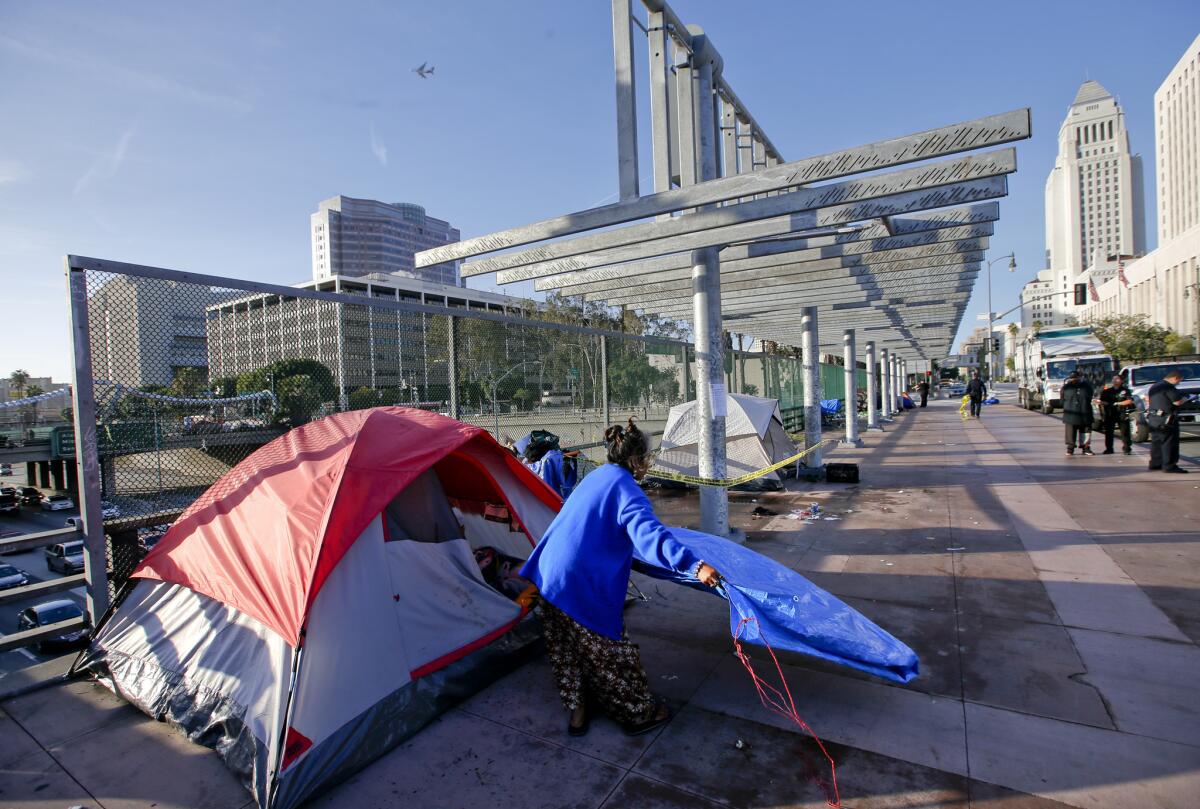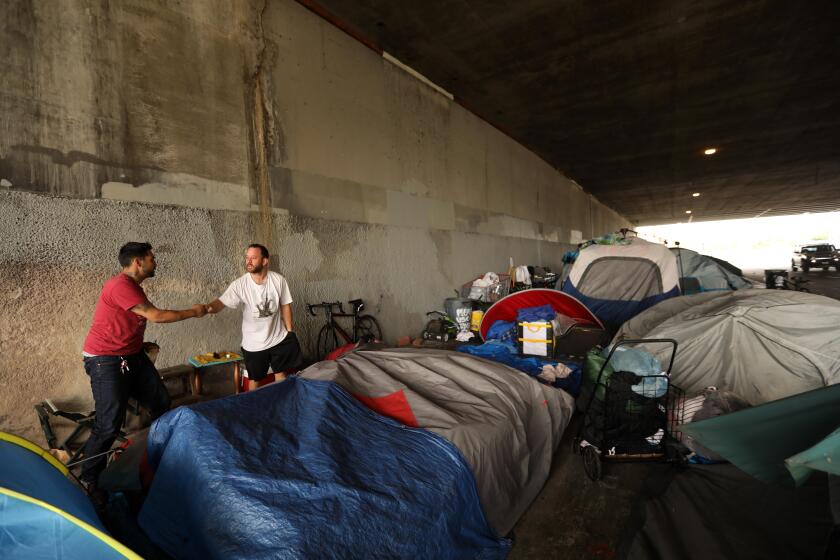Federal homelessness chief has harsh words for California: ‘You can’t tell me it’s working’

Robert Marbut is brand-new to his job as executive director of the agency that coordinates the federal government’s response to homelessness. But he is already criticizing the work being done to get people off the streets in California.
“If [it] was working, California should have the lowest numbers in the country, and it should be reducing,” he told The Times. “And instead for the last five years, it has gone the other direction. So you can’t tell me it’s working. ... To me, it’s that simple.”
For a state that is home to nearly a quarter of the country’s homeless population, these could be ominous words from a man who, as head of the U.S. Interagency Council on Homelessness, has sway over federal policy on homelessness and housing.

Since the summer, President Trump has been railing against Los Angeles and San Francisco for failing to get a handle on a growing number of homeless encampments. He has threatened to bring in the federal government, and rumors continue to swirl that the administration is drafting an executive order to crack down on homelessness, though it has yet to come to fruition and federal officials have offered few details of what it would entail.
“Homelessness has become a crisis that cannot be ignored,” White House spokesman Judd Deere said in a statement. “Earlier this year, President Trump directed his team to study the issue, including visiting areas where the crisis has become most extreme, and develop a range of common sense policy options for consideration to solve the problem. While some governors and mayors have helped create this situation only to ignore it, President Trump is not going to sit idly by.”
The appointment of Marbut has particularly concerned homeless advocates. As a Texas-based consultant, he spent years working for cities struggling with homelessness, and has long encouraged elected officials to stop coddling people on the streets, including by blocking charities from handing out food.
His philosophy is broadly in line with many of the Trump administration’s views.
In his interview with The Times, Marbut declined to say how he was vetted or selected for his new role. He declined to say whether he had spoken to the president. And he declined to say anything about future plans the administration has to address homelessness.
“We’re focused on where the humanitarian crises are now, and right now that is disproportionately the West Coast — and it’s pronounced in California,” he said. “And that’s just the fact of the numbers.”
Marbut pointed out that roughly 1,000 homeless people died in Los Angeles County in 2018 — nearly double the number from six years ago. Another 1,000 are likely to die by the end of this year. If the city, county or state’s plan for stemming the rising tide of people sleeping on the streets was effective, Marbut said, that wouldn’t be the case.
“I hate to make it this simplistic, but it really is this simplistic: If what was working was working, the numbers in California would be dramatically dropping and they’re not,” he said. “So that’s why the president is so focused and so concerned.”
This was the year that the unseemly sights, sounds and smells of people living on L.A. streets became inescapable, no matter where you lived or worked.
California has faced a complex confluence of skyrocketing housing prices, a shortage of affordable housing, and insufficient services to help the swelling numbers of people who have lost their homes or are on the verge of it. At the same time, Los Angeles has created a large outreach system and invested in the construction of thousands of units of supportive housing that are expected to be built in the coming years.
L.A. officials are quick to trumpet the tens of thousands of people they have gotten off the streets, but it’s become like bailing water out of a sinking ship. Every day in 2018, about 130 homeless people moved into housing, but another 150 people became homeless, according to county officials.
In a recent report, the White House Council of Economic Advisors blamed “decades of misguided and faulty policies” for putting too many restrictions on development and causing home prices to rise to unaffordable levels. It also posited that “more tolerable conditions for sleeping on the streets” increased the homeless population.
That squares with advice Marbut has given as a consultant. Some of his recommendations, such as having a single case management system for homeless people, fall squarely into mainstream best practices. But others don’t.
For example, he has repeatedly told cities that panhandling, as well as feeding the homeless, must be stopped because both enable homeless people to stay on the streets. This has led him to push cities to crack down on loitering and sleeping in public places.
But in the interview with The Times, he said his advice wasn’t that cut and dried.
“It was not don’t feed. It was don’t feed in Place X,” he said. “Move the feeding to the other services providers, so you have a more holistic use of services.”
Still, this view has been roundly criticized by homeless advocates, who say it’s ineffective and relies on the faulty assumption that homeless people stay on the street because handouts of food and money make it more hospitable.
Marbut recently met with about 30 housing and homeless advocates in Washington shortly after assuming the job at the Interagency Council. Many were critical of his past approaches.
Separately, 75 House Democrats also sent a letter to Trump calling for him not to appoint Marbut to the post. It didn’t work.
“What he recommends can be very appealing to people who believe homelessness is an individual failing and believe that the reason people have mental illness or addiction is because they refuse to take care of themselves,” said Barbara Poppe, a former executive director of the Interagency Council. “It blames them for the situation they’re in, as opposed to looking at what are the solutions that actually are successful at helping them address their health issues and their housing issues.”
The agency that Marbut now runs sits at the center of more than a dozen federal agencies that all have a hand in working on homelessness, including the departments of Housing and Urban Development, Veterans Affairs, and Health and Human Services. The Interagency Council doesn’t make direct funding decisions for programs, but it can create strategic plans to tackle homelessness, as it did under Poppe, and then roll those plans out to local communities and nonprofits.
Poppe says that her fear is that Marbut — at the behest of his like-minded colleagues in the Trump administration — will encourage ideas that focus too much on criminalizing homelessness and reduce a focus on getting people into long term housing.
She has personal experience. She was paid by Fresno Housing Authority to help address homelessness after the Central Valley city opted not to take Marbut’s advice.
The local business community had banded together to hire Marbut in 2013 to do a top-to-bottom assessment of the city’s homeless resources. It included Marbut going undercover and living on the streets for a time.
Marbut told one Fresno official that he would avoid bathing for a few days and then a pour a beer on himself so that he would fit in. Marbut didn’t dispute this in his interview with The Times and said that he found that “becoming homeless” — as he called it in his report — offers insight that can’t be gleaned any other way.
He recommended that Fresno build a shelter similar to the one he had helped create in San Antonio. Hundreds of homeless people slept in an outdoor courtyard at the facility with the hope that it would act as an incentive to enter Haven for Hope, which had rules including sobriety.
Preston Prince, executive director of the Fresno Housing Authority, visited San Antonio and met with Marbut. He said he was worried that Marbut’s recommendations for Fresno would be a departure from the “housing first” model, the widely accepted strategy that prioritizes getting people indoors and then helping them.
Prince also said they struggled to find data showing that the Texas shelter got people into permanent housing.
Fresno officials ended up not using his recommendations. Then they brought in Poppe, who said Marbut’s plan lacked any way for people to exit homelessness into permanent housing.
With Marbut as executive director of the Interagency Council on Homelessness, she said, “the concern is he’s going to promote a model that hasn’t been shown to have any efficacy in actually reducing homelessness. And I think there’s a lot of belief that it’s not a trauma informed model, so it’s actually hurting people rather than helping them.”
More to Read
Start your day right
Sign up for Essential California for news, features and recommendations from the L.A. Times and beyond in your inbox six days a week.
You may occasionally receive promotional content from the Los Angeles Times.








